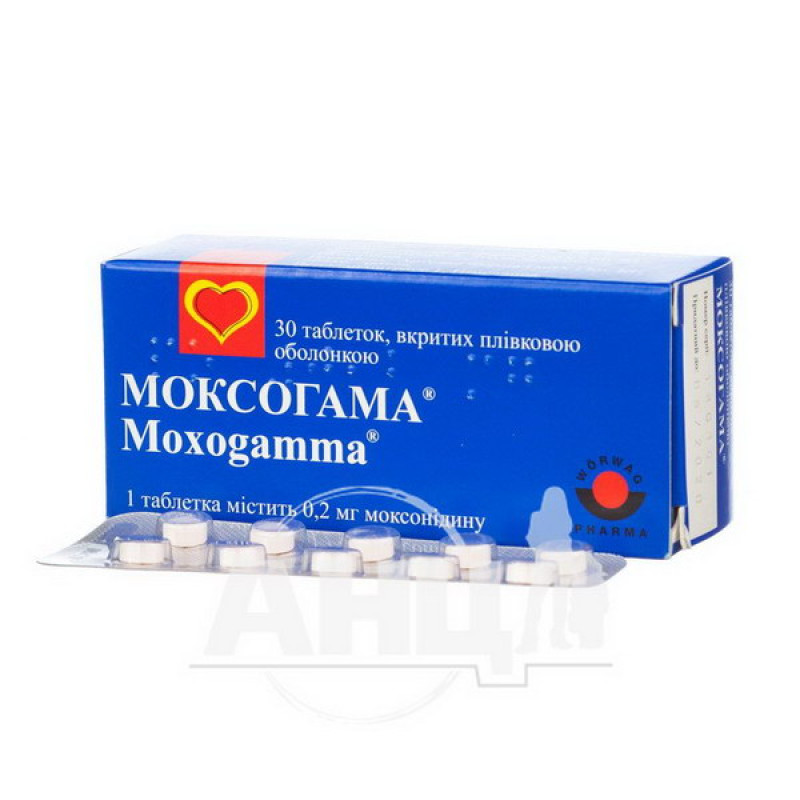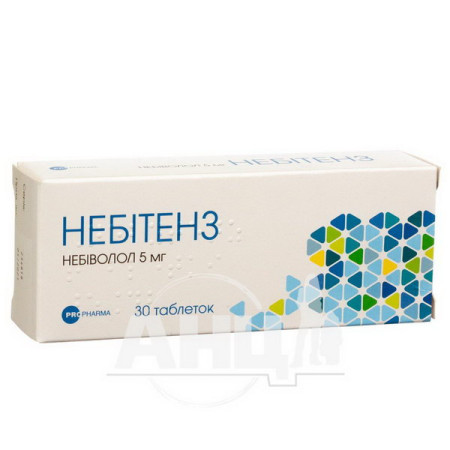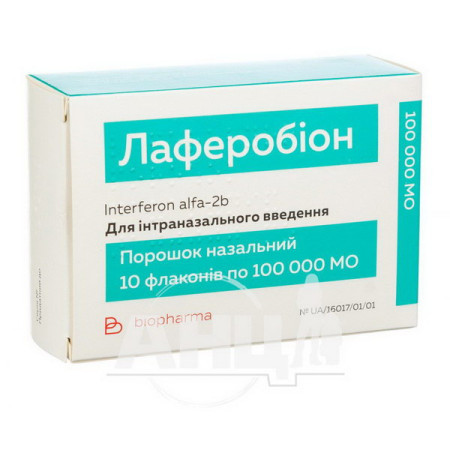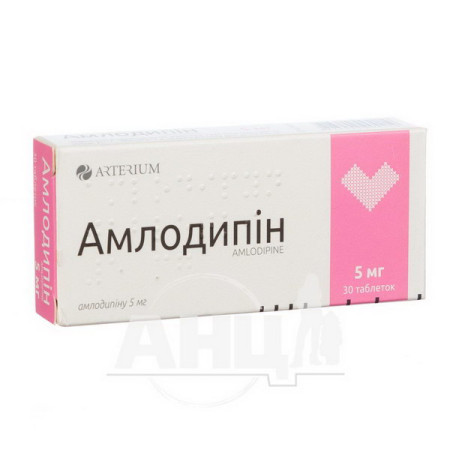Moxogama film-coated tablets 0.2 mg No. 30
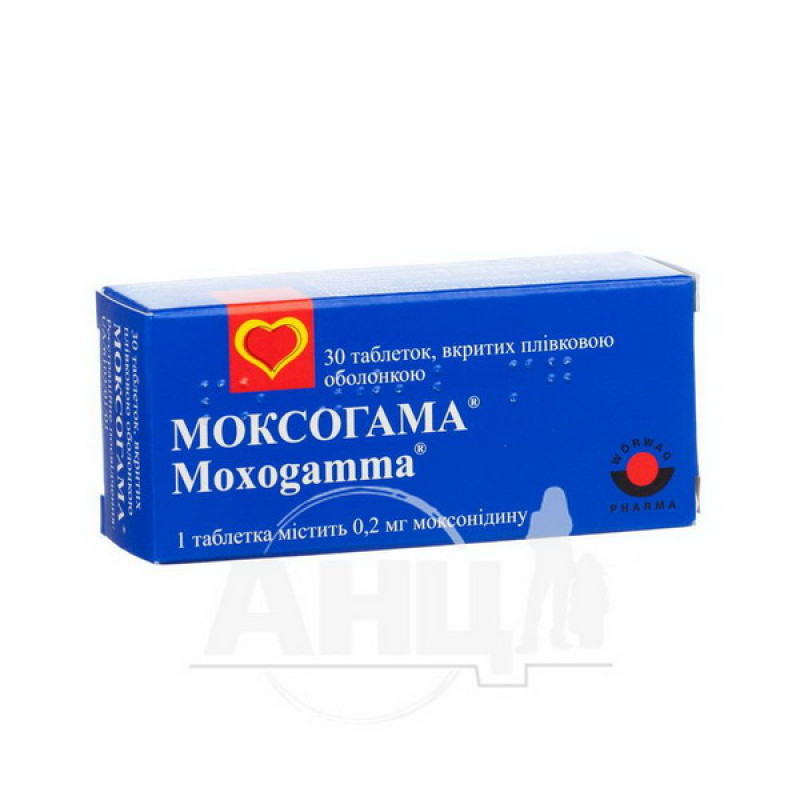
Instructions for Moxogam film-coated tablets 0.2 mg No. 30
Composition
active ingredient: moxonidine;
1 tablet contains moxonidine 0.2 mg or 0.3 mg or 0.4 mg;
excipients: lactose monohydrate, crospovidone, povidone K 25, magnesium stearate, Opadry U-1-7000 (contains hydroxypropylmethylcellulose, titanium dioxide (E 171), macrogol 400), iron oxide red (E 172).
Dosage form
Film-coated tablets.
Main physicochemical properties:
0.2 mg tablets: round, film-coated tablets, light pink in color;
0.3 mg tablets: round, film-coated tablets, pink in color;
0.4 mg tablets: round, film-coated tablets, dark pink in color.
Pharmacotherapeutic group
Antihypertensive agent. Antiadrenergic agent with a central mechanism of action. Imidazoline receptor agonist.
ATX code. C02A C05.
Pharmacological properties
Pharmacodynamics.
Moxonidine is a selective agonist of imidazoline receptors in the central nervous system.
In the brainstem, moxonidine binds selectively to imidazoline receptors. These imidazoline-sensitive receptors are located predominantly in the rostral ventrolateral medulla, an area that plays an important role in the central control of the sympathetic nervous system. The effect of this interaction with imidazoline receptors is to alter the activity of the sympathetic nervous system and to lower blood pressure.
Moxonidine differs from sympatholytic antihypertensive agents in its low affinity for central α-adrenergic receptors compared to its affinity for imidazoline receptors. Therefore, sedation and dry mouth are rare when using moxonidine. Moxonidine is an effective antihypertensive agent. The use of moxonidine leads to a decrease in peripheral vascular resistance with a subsequent decrease in blood pressure.
Pharmacokinetics.
Moxonidine is rapidly absorbed after oral administration. Approximately 90% of the dose is absorbed. There is no presystemic metabolism, and the bioavailability is 88%.
Only about 7% of moxonidine binds to blood plasma proteins.
Moxonidine is metabolized by 10-20%, mainly to 4,5-dihydromoxonidine and the aminomethanamidine derivative, by opening the imidazoline tubule. The hypotensive effect of 4,5-dihydromoxonidine is only 1/10, and of the aminomethanamidine derivative is less than 1/100 of that of moxonidine.
Moxonidine and its metabolites are almost completely excreted by the kidneys.
More than 90% of the dose is excreted in the urine within the first 24 hours, approximately 1% is excreted in the faeces. The total excretion of unchanged moxonidine is approximately 50-75%.
The mean elimination half-life of moxonidine and metabolites is approximately 2.5 hours and 5 hours, respectively.
In patients with moderate renal impairment (glomerular filtration rate 30-60 ml/min), clearance is reduced to 52%.
Pharmacokinetic studies in children have not been conducted.
Moxonidine penetrates the blood-brain and placental barriers and is excreted in breast milk.
Indication
Mild to moderate arterial hypertension.
Contraindication
Hypersensitivity to any component of the drug;
sick sinus syndrome or sinoatrial heart block;
bradycardia (less than 50 beats per minute at rest);
atrioventricular block of the 2nd or 3rd degree;
heart failure.
Interaction with other medicinal products and other types of interactions
Concomitant use of the drug with other antihypertensive agents has an additive effect.
Since tricyclic antidepressants may reduce the effectiveness of centrally acting antihypertensive agents, the concomitant use of these drugs with moxonidine is not recommended.
Moxonidine may potentiate the effect of tricyclic antidepressants (simultaneous administration should be avoided), tranquilizers, alcohol, sedatives and hypnotics.
Moxonidine moderately increases cognitive impairment in patients receiving lorazepam. It may also enhance the sedative effect of benzodiazepines when used concomitantly.
Moxonidine is eliminated by tubular excretion. Interactions with agents eliminated by tubular excretion cannot be excluded.
Application features
Moxonidine should be used with extreme caution in patients with first-degree atrioventricular block to avoid bradycardia.
Moxonidine should be used with caution in patients with severe ischemic heart disease or unstable angina, as experience with the drug in such patients is limited.
If moxonidine is used in combination with β-blockers and both drugs need to be discontinued, the β-blocker should be discontinued first, followed by moxonidine after a few days.
To date, no withdrawal effects on blood pressure have been observed after discontinuation of moxonidine. However, abrupt discontinuation of moxonidine therapy is not recommended; instead, the dose should be gradually reduced over a period of 2 weeks.
Patients with rare hereditary problems of galactose intolerance, the Lapp lactase deficiency or glucose-galactose malabsorption should not take this medicine.
Use during pregnancy or breastfeeding
There are no adequate data on the use of moxonidine in pregnant women. Animal studies have shown toxic effects on the fetus. The potential risk to humans is unknown. Moxonidine should not be used during pregnancy unless clearly necessary.
Moxonidine is excreted in breast milk and therefore should not be used during breastfeeding. If therapy with moxonidine is necessary, breastfeeding should be discontinued.
Ability to influence reaction speed when driving vehicles or other mechanisms
Studies on the effect of the drug on the ability to drive or operate machinery have not been conducted. However, drowsiness and dizziness have been reported. This fact should be taken into account when performing such tasks.
Method of administration and doses
Adults.
Treatment should be started with the lowest dose of moxonidine – 0.2 mg per day. If the therapeutic effect is insufficient, after 3 weeks the dose can be increased to 0.4 mg. This dose can be taken once (in the morning) or divided into 2 doses (in the morning and in the evening). If the results are unsatisfactory over the next 3 weeks, the dose can be increased to a maximum of 0.6 mg, taken in 2 doses, in the morning and in the evening. A single dose of 0.4 mg of moxonidine and a maximum daily dose of 0.6 mg of moxonidine should not be exceeded. The dose of the drug should be selected individually, depending on the patient's response.
The drug can be taken regardless of food intake. The tablet should be taken with sufficient liquid.
Elderly patients. If there is no renal insufficiency, the dosage is the same as for adults.
Renal impairment. For patients with moderate renal impairment (glomerular filtration rate > 30 ml/min but < 60 ml/min) and for patients on haemodialysis, the initial dose should not exceed 0.2 mg, and the dose may be increased if necessary. Moxonidine is contraindicated in patients with severe renal impairment (glomerular filtration rate < 30 ml/min).
Hepatic impairment. There are no clinical data for patients with impaired liver function. However, moxonidine is not metabolized in the liver, and no significant effect on its pharmacokinetics is expected. Therefore, the dosage for patients with mild to moderate hepatic impairment is recommended to be the same as for adults. The drug should not be discontinued abruptly, as the possibility of rebound hypertension as a "withdrawal effect" cannot be completely excluded. The drug should be discontinued over a period of 2 weeks, gradually reducing the dose.
Children.
The efficacy and safety of the drug in children have not been established, so the drug should not be prescribed to this age group.
Overdose
In isolated cases, overdose of moxonidine, even at a dose of 19.6 mg per day, did not lead to a fatal outcome. Symptoms of overdose include headache, sedation, drowsiness, hypotension, dizziness, general weakness, bradycardia, dry mouth, vomiting, upper abdominal pain and malaise. In case of severe overdose, careful monitoring for impaired consciousness and especially respiratory depression is recommended. Based on studies of high doses of the drug in animals, transient arterial hypertension, tachycardia and hyperglycemia can additionally be expected.
Specific antidotes are unknown. In case of arterial hypotension, the use of dopamine and the introduction of plasma-replacing solutions are recommended to maintain hemocirculation. Atropine may be effective in the event of bradycardia.
α-Adrenoceptor antagonists may reduce or eliminate the paradoxical hypertensive effects of moxonidine overdose.
Side effects
The most common side effects of moxonidine include dry mouth, dizziness, drowsiness, and general weakness/asthenia. These symptoms often improve after a few weeks of treatment.
Nervous system: headache, dizziness/vertigo, drowsiness, fainting.
Gastrointestinal: dry mouth, diarrhea, nausea/vomiting, dyspepsia.
From the side of the organs of vision and labyrinth: ringing in the ears.
Skin and subcutaneous tissue disorders: hypersensitivity reactions, including rash, itching; angioedema.
Cardiovascular system: bradycardia, arterial hypotension (including orthostatic hypotension).
Musculoskeletal and connective tissue disorders: back pain, neck pain.
Mental disorders: insomnia; nervousness.
General disorders: asthenia; edema.
Expiration date
2 years for 0.2 mg dosage. 3 years for 0.3 mg and 0.4 mg dosage.
Storage conditions
Store in the original packaging at a temperature not exceeding 30 °C, out of the reach of children.
Packaging
10 film-coated tablets in a blister, 3 blisters in a cardboard box, 25 film-coated tablets in a blister,
2 blisters in a cardboard box.
Vacation category
According to the recipe.
Producer
Artesan Pharma GmbH & Co. KG, Germany.
Location of the manufacturer and its address of the place of implementation of the activity
29439, Luechow, Wendlandstrasse 1/29439, Luechow, Wendlandstrasse 1.
There are no reviews for this product.
There are no reviews for this product, be the first to leave your review.
No questions about this product, be the first and ask your question.



